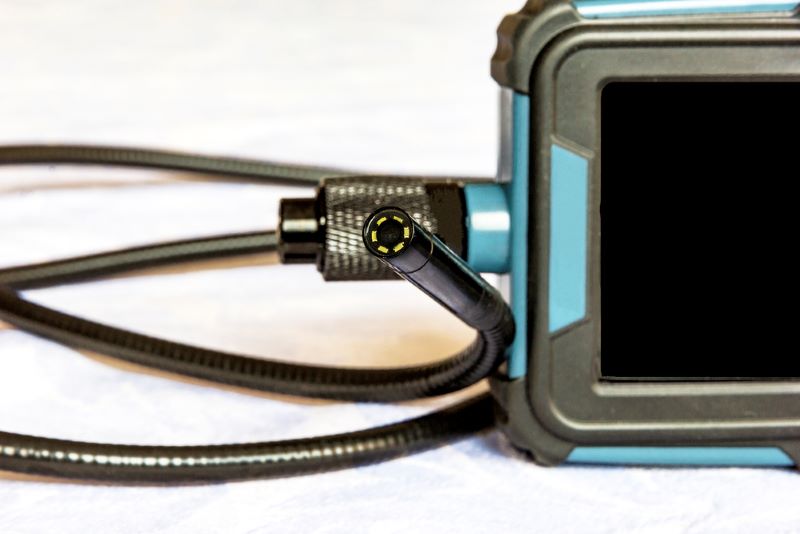Click here to get this post in PDF
Visual inspection is a fundamental nondestructive testing (NDT) method that involves examining products or materials with the naked eye or with the help of magnifying devices. It is a simple yet effective technique for detecting surface defects and anomalies, often using an inspection camera.
Visual inspection plays a crucial role in ensuring product quality and safety across various industries. Identifying defects early in the manufacturing process through visual inspections can prevent costly product failures and mitigate risks to consumers. This comes especially handy for high-stakes industries, where product failures can have severe consequences. Visual inspection emerges as an essential component of quality assurance programs in such scenarios. Let’s explore how.
The Human Eye as a Powerful Tool
The human eye is a highly sophisticated organ capable of perceiving a wide range of visual information. It can detect subtle variations in color, texture, and shape, making it well-suited for identifying defects in products and materials.
Visual inspection allows the detection of anomalies that may be difficult to detect using other NDT methods. The human eye can quickly identify inconsistencies that may indicate a defect, such as cracks, scratches, pits, or foreign objects. This ability is particularly valuable in industries where even minor defects can have significant consequences.
For example, in the aerospace industry, visual inspections have proved valuable for detecting cracks in aircraft components, which could otherwise compromise safety. In the food and beverage industry, visual inspections are used to identify contaminants that could pose a health risk to consumers. In these and other high-stakes industries, the human eye remains a valuable tool for ensuring product quality and safety.
Visual Inspection in Critical Industries
Visual inspection is indispensable in ensuring the quality and safety of products in critical industries. In the aerospace industry, where even minor defects can have catastrophic consequences, visual inspections can help detect cracks, corrosion, and other anomalies in aircraft components. These inspections help maintain the structural integrity of aircraft and ensure the safety of passengers and crew.
In the automotive industry, visual inspections help identify defects in components such as engines, transmissions, and body panels. These inspections help guarantee the performance, durability, and reliability of vehicles.
In the medical device manufacturing industry, visual inspections are essential for ensuring the quality and safety of medical devices. Defects in medical devices can have serious consequences for patients, and visual inspections help to prevent such occurrences.
The food and beverage industry relies heavily on visual inspection to ensure product safety and quality. Visual inspections help detect contaminants like foreign objects or mold, and to verify that products meet regulatory standards. Identifying and addressing potential hazards using visual inspections thus helps protect consumers from foodborne illnesses.
Advanced Visual Inspection Techniques
While traditional visual inspection remains a valuable tool, advancements in technology have led to the development of more sophisticated techniques.
Endoscopy and boroscopy are examples of advanced visual inspection methods that help examine internal cavities and inaccessible areas. These techniques are particularly useful in industries like aerospace, automotive, and medical device manufacturing, where components not visible to the naked eye are commonly inspected.
High-resolution cameras and imaging systems have also enhanced visual inspection capabilities. These technologies provide detailed images that help detect subtle defects. Computer-aided visual inspection systems can also be used to analyze images and identify anomalies more accurately and consistently than human inspectors. Incorporating these advanced techniques can help organizations improve the efficiency and reliability of their visual inspection processes.
Challenges and Limitations of Visual Inspection
Despite its many advantages, visual inspection is not without its challenges and limitations.
One of the primary challenges is the subjectivity involved in human visual perception. Different individuals may interpret visual information differently, leading to inconsistencies in defect detection. This subjectivity can be mitigated by using standardized guidelines and training programs, but it remains a potential source of error.
Another limitation of visual inspection is its inability to detect internal defects. While visual inspection can effectively identify surface defects, it cannot reveal flaws hidden beneath the surface. This is where other NDT methods, such as radiographic or ultrasonic testing, become essential.
Visual inspection is, therefore, often combined with other NDT techniques to address its limitations. This multi-method approach can help obtain a more comprehensive assessment of product quality and safety. For instance, visual inspection can be used to identify potential defects, which can then be further investigated using other NDT methods.
Conclusion
Visual inspection remains an essential component of quality assurance in high-stakes industries. The human eye’s ability to detect subtle anomalies and inconsistencies makes it an invaluable tool for identifying defects that could have serious consequences. While technological advancements have introduced new NDT methods, visual inspection continues to play a vital role in ensuring product quality and safety.
The future of visual inspection is likely to be shaped by new and emerging technologies as we proceed. As new imaging technologies and computer-aided systems come to the fore, visual inspection will become even more accurate and efficient. However, it is important to recognize that visual inspection is not a standalone solution. A comprehensive approach to quality assurance requires a combination of visual inspection with other NDT methods to ensure the highest standards of product quality and safety.
You may also like: 5 Reasons To Hire A Petroleum Inspection Company
Image source: DepositPhotos.com

